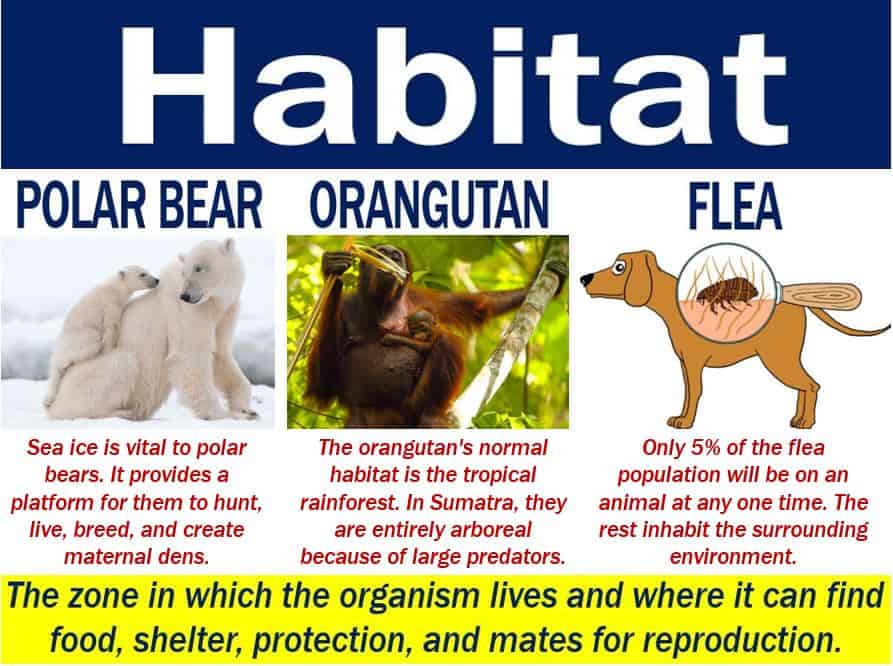The term Habitat may refer to a person’s, animal’s, plant’s, or other organism’s natural environment. It can mean somebody’s preferred or usual surroundings. When referring to non-human life forms, it only means their natural home or environment. Moisture, rainfall, light, and temperature, for example, are some physical factors that make up most habitats.
Some habitats, such as those of microscopic organisms, are tiny. However, the habitats of whales span many thousands of miles.
The term may also refer to artificial housing in inhospitable places, such as on the moon.
Additionally, the concept of habitat is central to the field of conservation biology, where the protection and restoration of habitats is key to preserving biodiversity and ensuring the survival of species
Urban habitats, created by human development, present unique challenges and opportunities for wildlife, often leading to novel adaptations and ecological interactions not observed in natural settings.

Habitat – where an organism exists
The term refers to the zone where a life form (organism) lives. It is where it can find shelter, mates, and food.
Organisms’ habitats are the natural environments in which they live. The term also means a population’s physical environment, i.e., the environment that surrounds a species population.
Habitats are either geographical areas or parts of things. In fact, they might even be parts of other organisms. It could be a rotten log, a clump of moss, under a rock, or the interior of a stem.
For a parasite; it is the host’s body. For example, a tapeworm’s habitat could be a human being; specifically a human’s gut. Tapeworms are flat, ribbon-like worms that live inside a host (human, dog, cat, etc.).
The human habitat is the environment in which we exist and interact. For example, a house is our habitat, where we sleep and eat.
Some animal populations are declining rapidly because their habitats are disappearing. The orangutan population in Indonesia, for example, has been plummeting. Humans have been burning their habitat to the ground.
Many migratory bird species are at risk of extinction due to habitat loss along their flight paths. The ARC Centre of Excellence for Environmental Decisions said that 90% of migratory birds globally need significantly more protection.
Habitat – etymology
Etymology is the study of where words came from and how their meanings have developed. Somebody who studies the origin of words is an etymologist.
According to the Online Etymology Dictionary, the word ‘habitat’ has been in use since 1762. It was originally a technical term in Latin texts on English fauna and flora.
The Latin third person singular present indicative of Habitare means ‘to inhabit, live, or dwell.’
The Online Etymology Dictionary adds:
“This was the Modern Latin word that began the part of the scientific description of a plant or animal species that told its locality. General sense of ‘dwelling place’ is first attested 1854.”
Many compound phrases with ‘habitat’
From the word ‘habitat,’ we get many compound phrases. Let’s look at some common ones:
-
Habitat Fragmentation
Breaking larger habitats into smaller, isolated ones. As in:
“The construction of a new highway has led to habitat fragmentation, adversely affecting the local wolf population.”
-
Habitat Conservation
Protecting natural habitats to support species survival. For example:
“The national park’s strict regulations are an effort towards habitat conservation for the endangered mountain gorilla.”
-
Habitat Restoration
Reverting environments to their natural states. For instance:
“After the removal of the invasive species, the habitat restoration project successfully reestablished the native plant community.”
-
Habitat Management
Manipulating environments to benefit certain species. As in:
“Wildlife biologists engage in habitat management by periodically burning underbrush to maintain the prairie ecosystem.”
-
Habitat Suitability
The adequacy of an environment for a species’ needs. For example:
“The wetland’s high nutrient levels and ample water supply increase its habitat suitability for migratory birds.”
